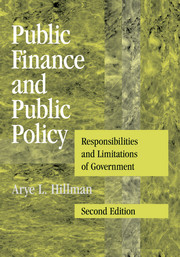Book contents
- Frontmatter
- Contents
- Preface to the Second Edition
- 1 MARKETS AND GOVERNMENTS
- 2 INSTITUTIONS AND GOVERNANCE
- 3 PUBLIC GOODS
- 4 PUBLIC FINANCE FOR PUBLIC GOODS
- 5 MARKET CORRECTIONS
- 6 VOTING
- 7 SOCIAL JUSTICE
- 8 ENTITLEMENTS
- 9 CHOICE OF TAXATION
- 10 THE NEED FOR GOVERNMENT
- TOPICS FOR DISCUSSION
- Author Index
- Subject Index
- References
8 - ENTITLEMENTS
- Frontmatter
- Contents
- Preface to the Second Edition
- 1 MARKETS AND GOVERNMENTS
- 2 INSTITUTIONS AND GOVERNANCE
- 3 PUBLIC GOODS
- 4 PUBLIC FINANCE FOR PUBLIC GOODS
- 5 MARKET CORRECTIONS
- 6 VOTING
- 7 SOCIAL JUSTICE
- 8 ENTITLEMENTS
- 9 CHOICE OF TAXATION
- 10 THE NEED FOR GOVERNMENT
- TOPICS FOR DISCUSSION
- Author Index
- Subject Index
- References
Summary
A social insurance contract provides entitlements. Entitlements are of two types: (1) universal and therefore intended for all as a means of seeking ex-ante equality; or (2) targeted to designated groups, who are given the entitlements because of designated needs. Section 1 of this chapter considers whether or how entitlements can achieve equality of opportunity (or ex-ante equality) and investigates the consequences of entitlements for incentives. Section 2 is about the entitlement to income during retirement or old age. The topic of section 3 is the entitlement to health care and health insurance.
The Attributes and Consequences of Entitlements
The entitlements that are part of a social insurance contract can be provided in the form of income transfers (money) or as in-kind transfers. In the previous chapter, we viewed the entitlements as income or money paid by people who had experienced good outcomes to people who had experienced adverse outcomes. Often, however, entitlements are in-kind, in the form of education, housing, food vouchers, and health care, as well as advice from social workers about how to obtain access to entitlements. In-kind transfers provide designated goods and services: money can be transferred to anyone for any purpose.
Money and in-kind transfers
Our first questions concern the choice between money and in-kind transfers as means of delivery of entitlements.
The choice between money and in-kind transfers
Our normative question is:
Should the entitlements of a social insurance contract be provided as income or as in-kind transfers?
- Type
- Chapter
- Information
- Public Finance and Public PolicyResponsibilities and Limitations of Government, pp. 587 - 664Publisher: Cambridge University PressPrint publication year: 2009



